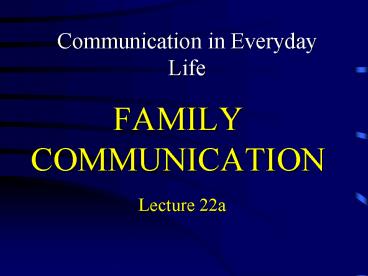FAMILY COMMUNICATION Lecture 22a - PowerPoint PPT Presentation
1 / 27
Title:
FAMILY COMMUNICATION Lecture 22a
Description:
Title: FAMILY COMMUNICATION Author: Dalton Kehoe Last modified by: Neil Bowen Created Date: 3/10/2000 1:00:38 AM Document presentation format: On-screen Show (4:3) – PowerPoint PPT presentation
Number of Views:296
Avg rating:3.0/5.0
Title: FAMILY COMMUNICATION Lecture 22a
1
FAMILY COMMUNICATION Lecture 22a
- Communication in Everyday Life
2
WHY FAMILIES?
3
FAMILY DEFINITION
- Family networks of people who share their
lives over long periods of time who are bound by
ties of marriage, blood or commitment, legal or
otherwise who consider themselves as family and
who share future expectations of connected
relationship - AR
4
FUNCTIONS OF THE FAMILY
- Internal
- Provide care
- Socialization
- Intellectual development
- Emotional support and development
- Recreation
- External
- Transmission of cultural values
- Adaptation to social change
5
STRUCTURES OF THE FAMILY
- POWER-AUTHORITY STRUCTURE
- POWER HELD BY ONE OR BOTH PARENTS
- CHILDREN DEVELOP OWN POWER
- CLEAR AUTHORITY LINE OR VARIABLE
- DECISION-MAKING STYLE
- FORCING/ACCOMMODATION/COMPROMISE
- COLLABORATION
- AD HOC
- INTERACTION STRUCTURE
- WHO TALKS TO WHOM ABOUT WHAT
6
(No Transcript)
7
FAMILY COMMUNICATION Lecture 22b
- Communication in Everyday Life
8
FAMILIES AS PEOPLE-MAKING FACTORIES
- FAMILY COMMUNICATION SHAPES
- SELF-CONCEPT AND SELF-ESTEEM
- COGNITIVE AND EMOTIONAL DEVELOPMENT
- PARTICULARLY WHEN CHILDS BEHAVIOR DOESNT FIT
FAMILY RULES
9
FAMILY COMMUNICATION RULES
- Regulative rules - guides to action
- Obligatory explicit you must you have to
or implicit example setting - Appropriate not force of obligation but deemed
good behavior - Constitutive rules - how certain communicative
acts are to be counted - Helping your brother means you care
- Snide remarks are a sign of disrespect
10
HOW THE FAMILY COMMUNICATES ITS VIEWS OF CHILD
REVIEW
- Direct definition
- Labels ( and -) and instruction
- Not only defines self but self-worth (role names
and character names) - Identity scripts
- Who we are, how we are supposed to live,
including T.A.S ok/not ok life positions - Attachment styles
- Secure, fearful, dismissive, anxious
11
ATTACHMENTS STYLES
BASED ON FIRST BOND WITH PARENT
CAREGIVER CONSISTENTLY LOVING AND ATTENTIVE
CAREGIVER INCONSISTENT - SOMETIMES LOVING THEN
REJECTING
CAREGIVER CONSISTENTLY NEGATIVE, REJECTING,
ABUSIVE
CAREGIVER UNINTERESTED, REJECTING
12
PARENT TALK
- THE MESSAGE
- (CONTENT)
- VERSUS THE
- METAMESSAGE
- (RELATIONSHIP)
Video Example
13
PARENT TALK
- THE MESSAGE
- (CONTENT)
- VERSUS THE
- METAMESSAGE
- (RELATIONSHIP)
14
PARENTING STYLES
Hi
Responsive
Lo
Lo
Hi
Demanding
15
(No Transcript)
16
FAMILY COMMUNICATION Lecture 22c
- Communication in Everyday Life
17
PARENTING GOALSBE RIGHT OR DEVELOP CHILDS
CHARACTER (EQ)?
LIGHT C.O.N.T.R.O.L. TALK VARIABLE
EFFECTIVNESS
- Teaching
- Advising
- Coaching
- Placating
- Lecturing
- Judging
- Derailing
- Mind Reading
- Moralizing
- Ineffective praising
18
PARENTING GOALSBE RIGHT OR DEVELOP CHILDS
CHARACTER (EQ)?
HEAVY C.O.N.T.R.O.L. TALK INEFFECTIVE
- Ordering
- Threatening
- Pitying
- Shaming
- Interrogating
- Denying
19
AUTHORITATIVE PARENTING MEANS D.I.A.L.O.G.U.E.
- DESCRIPTION
- Try to stay as close to the bottom of the
inference ladder as possible - Description is about what is (as you perceive,
understand it) not about how it should be - I-MESSAGES
- Start with I - Acknowledge other, describe your
perceptions, needs, wants - ASKING QUESTIONS
- The 4w2H questions - to seek info and create
support not defense
20
ASKING QUESTIONS IN D.I.A.L.O.G.U.E.
- DONT JUDGE - SUPPORT
- ASK QUESTIONS(4W2H)
- WHAT -WHERE
- WHEN - WHO
- HOW-HOW MUCH
- MAKE DIDYA? WHAT DIDYA?
- CREATE SAFE PLACE FOR CHILD TO TALK
- CLIMATE OF TRUST
21
AUTHORITATIVE PARENTING MEANS D.I.A.L.O.G.U.E.
- LISTENING ACTIVELY
- Only ask questions to clarify, not to give your
opinion or tell your story. - Reflect back in your own words what other is
thinking and feeling,to show full understanding. - Avoid telling them what they should be thinking/
feeling and avoid giving advice unless asked.
22
AUTHORITATIVE PARENTING MEANS D.I.A.L.O.G.U.E.
- LISTENING ACTIVELY
- Only ask questions to clarify, not to give your
opinion or tell your story. - Reflect back in your own words what other is
thinking and feeling,to show full understanding. - Avoid telling them what they should be thinking/
feeling and avoid giving advice unless asked.
- OPEN ACKNOWLEDGMENT
- I-message to show you understand from their point
of view. - GENUINE SUPPORT
- I-message(s) to affirm, compliment, thank or
explain how things could go better
23
WHEN CHILDREN ACT UP
- Parent try various methods with no success.
- time-outs,
- reward systems,
- Scolding - stop being a baby and
- spanking
- Why no success?
- Rather than addressing their childrens feelings,
they are putting a lid on them - They have failed to address the real fuel source
of their behavior their emotions - M. S. Kurcinka, Parents, Kids and Power Struggles
24
TWO KINDS OF PARENTAL RESPONSES
- AUTHORITATIVE STYLE INDUCTION
- SELF-DISCPLINE AND EMOTIONAL SELF-MANAGEMENT
- TALK WITH CHILD
- HELP CHILDREN UNDERSTAND WHY THEY SHOULD FOLLOW
RULES AND MANAGE THEIR EMOTIONS - THE CHILD LEARNS TO SELF-MANAGE
- AUTHORITARIAN STYLE CONTROL
- EXTERNAL DISCIPLINE
- POWER ASSERTION -ACTIVE C.O.N.T.R.O.L
- LOVE WITHDRAWAL-PASSIVE C.O.N.T.R.O.L
- BOTH SHORT TERM FIXES
25
EFFECTIVE DISCIPLINE FEEDBACK
- FEEDBACK FOR INDUCTION
- Non-Judgmental
- Point of view child is good, loved. Use
descriptive language, adult voice. - Specific
- Focus on particular behaviour/situation
- Immediate
- Do it as close to occurrence as possible
- Ask Questions
- Get their views, understanding, feelings about
what happened
26
EFFECTIVE DISCIPLINE FEEDBACK
- Consistent
- Predictability, follow rules youve set, keep
promises - Disclose
- Describe your own feelings (I-messages) Vs.
tell them their feelings (You message) - Congruent
- Verbals and non-verbals match. Kids particularly
vulnerable to incongruency. Double-bind effect. - Likely to create internal ethical standards -
apply without parent there - Basis for Development of Emotional Intelligence
27
(No Transcript)































